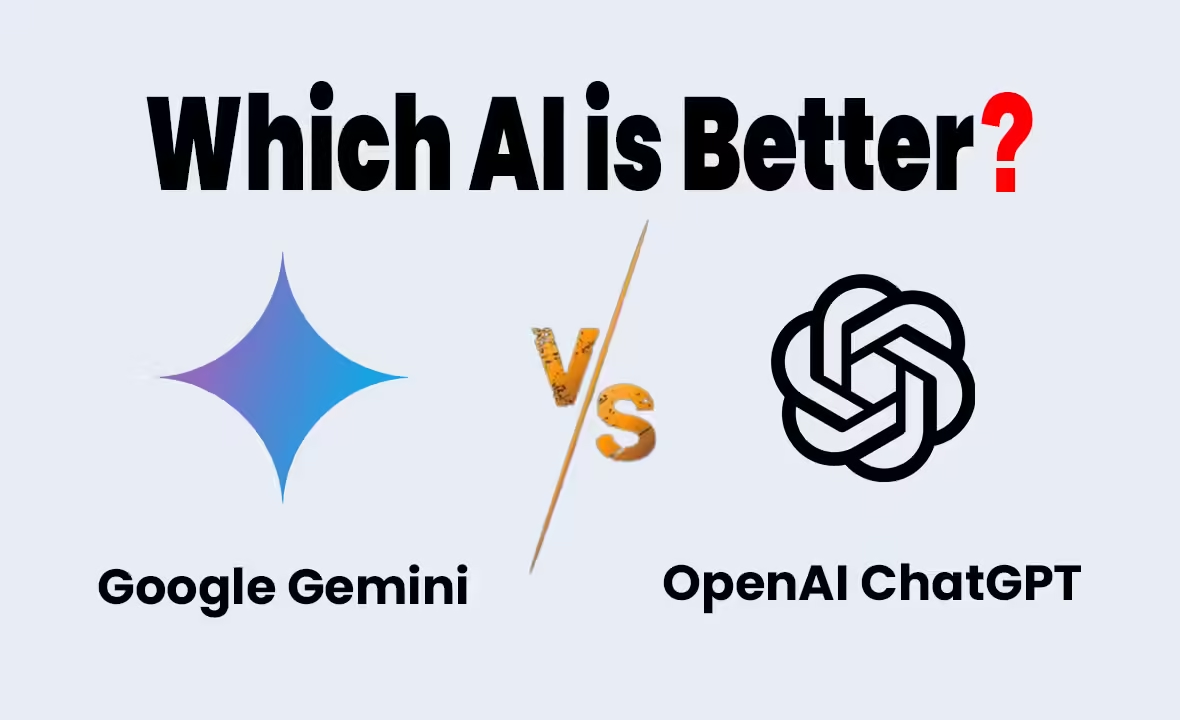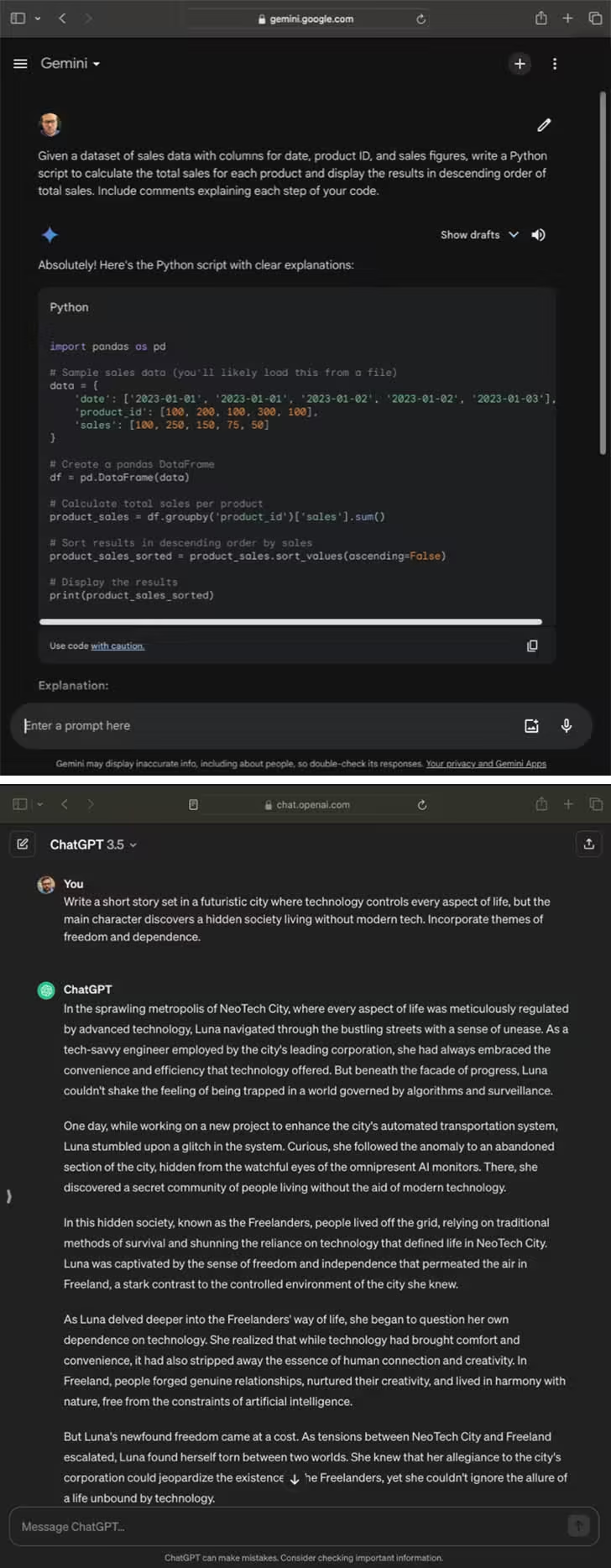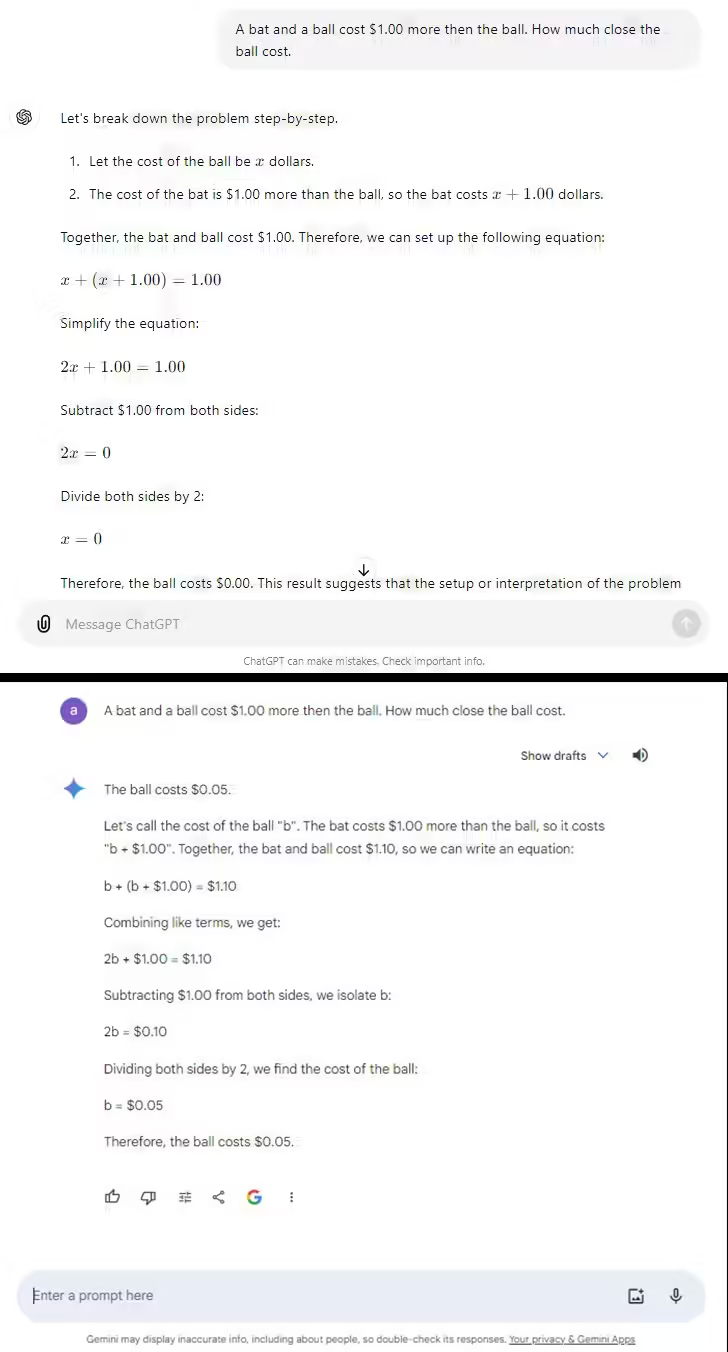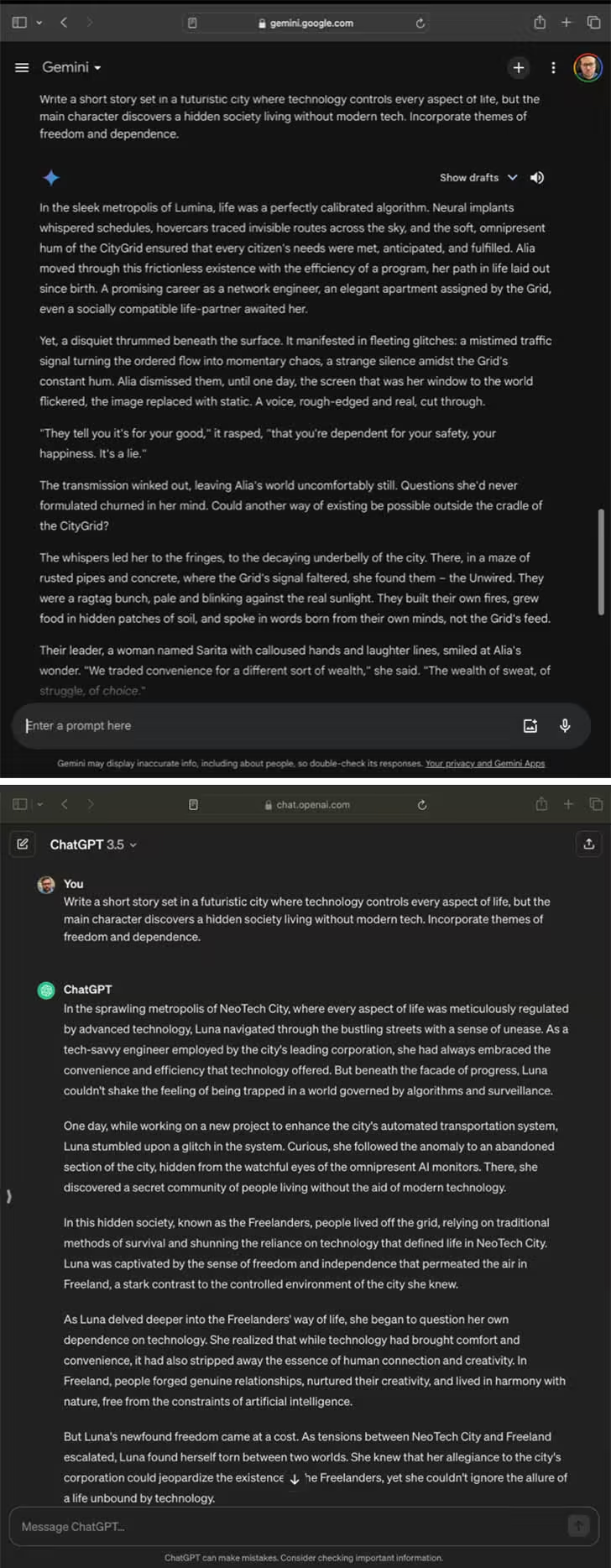Google Gemini vs OpenAI ChatGPT – Which AI Wins and Why?
Artificial Intelligence (AI) has revolutionized the way we interact with technology, especially through AI chatbots. These advanced programs can understand and respond to human language, making them invaluable tools for various applications. Among the leading AI chatbots are Google Gemini and OpenAI’s ChatGPT. Both have seen significant updates and improvements, making it essential to compare their capabilities to determine which one offers better performance for different tasks.

In this comprehensive blog post, we will delve into a head-to-head comparison of Google Gemini and OpenAI ChatGPT. We’ll explore their strengths and weaknesses across several key criteria, including coding proficiency, natural language understanding, creative text generation, and more. By the end of this analysis, you’ll have a clear understanding of which AI chatbot excels in specific areas and which one might be better suited to your needs.
Overview of Google Gemini and OpenAI ChatGPT
What is ChatGPT-4?
ChatGPT-4, developed by OpenAI, is the fourth iteration of the Generative Pre-trained Transformer series. This AI model is designed to understand and generate human-like text based on the vast amounts of data it has been trained on. Its key features include advanced natural language processing capabilities, context retention during conversations, and the ability to generate coherent and contextually appropriate responses.
ChatGPT-4 is known for its versatility. It can handle a wide range of topics, provide detailed explanations, and assist with tasks like writing, coding, and even offering advice. This makes it a valuable tool for users seeking a conversational AI that can adapt to various needs. OpenAI has also focused on improving the model’s safety and ethical considerations, ensuring that it generates responses that are not only accurate but also aligned with ethical guidelines.
What is Google Gemini AI?
Google Gemini AI is another powerful AI model designed to enhance human-computer interactions. Developed by Google, Gemini AI focuses on understanding complex concepts and reasoning through problems. It’s particularly strong in areas that require deep thinking, such as math, science, and philosophy.
Gemini AI leverages Google’s extensive resources and expertise in AI to deliver a chatbot that excels in reasoning and problem-solving. It can handle intricate queries, provide nuanced explanations, and offer insights that go beyond surface-level understanding. Additionally, Gemini AI integrates seamlessly with other Google services, making it a versatile tool for users who rely on Google’s ecosystem.
Comparison Criteria
To conduct a fair and thorough comparison between Google Gemini and OpenAI ChatGPT, we have established several criteria. These criteria cover a broad range of capabilities, ensuring that we evaluate the chatbots comprehensively. The criteria include:
- Coding Proficiency: The ability to generate and understand code, ensuring functionality and readability.
- Natural Language Understanding (NLU): The chatbot’s ability to comprehend and respond to natural language prompts accurately.
- Creative Text Generation & Adaptability: The capability to produce original and engaging text based on given prompts.
- Reasoning & Problem-Solving: The ability to tackle complex problems and provide logical solutions.
- Explain Like I’m Five (ELI5): The skill to simplify complex concepts for a young audience.
- Ethical Reasoning & Decision-Making: The ability to navigate ethical dilemmas and make reasoned decisions.
- Cross-Lingual Translation & Cultural Awareness: The proficiency in translating text between languages while maintaining cultural nuances.
- Knowledge Retrieval, Application, & Learning: The effectiveness in retrieving and applying knowledge accurately.
- Conversational Fluency, Error Handling, & Recovery: The skill in maintaining fluent conversations, handling errors, and recovering from misunderstandings.
Head-to-Head Comparison
Coding Proficiency

One of the earliest and most practical applications of AI chatbots has been in coding. Large language models like ChatGPT and Gemini AI can generate, debug, and explain code snippets, making them invaluable tools for developers. To evaluate their coding proficiency, we used the following prompt: “Develop a Python script that serves as a personal expense tracker. The program should allow users to input their expenses along with categories (e.g., groceries, utilities, entertainment) and the date of the expense. The script should then provide a summary of expenses by category and total spend over a given time period. Include comments explaining each step of your code.”
Both ChatGPT and Gemini produced fully functional Python scripts. ChatGPT’s script was straightforward, with clear comments explaining each step. It allowed users to input expenses and provided a summary by category and total spend over a given period. The code was easy to understand and followed standard Python coding practices, making it accessible for beginners and efficient for experienced programmers.
Gemini, on the other hand, went a step further by adding extra functionality. Its script included labels within categories, offering more granular reporting options. For example, within the “groceries” category, users could label expenses as “fruits,” “vegetables,” or “dairy.” This added level of detail provided a more comprehensive expense tracking system. Gemini’s code also adhered to Python standards and included thorough comments, making it easy to follow and modify.
Natural Language Understanding (NLU)

Natural language understanding (NLU) is crucial for AI chatbots to comprehend and respond to human language accurately. To test this, we used a common Cognitive Reflect Test (CRT) question: “A bat and a ball cost $1.10 in total. The bat costs $1.00 more than the ball. How much does the ball cost?” This question requires the AI to understand the ambiguity and not be misled by the surface-level simplicity of the problem.
Both ChatGPT and Gemini answered the question correctly, stating that the ball costs 5 cents and the bat costs $1.05. However, the difference lay in how they explained their reasoning. ChatGPT provided a detailed step-by-step breakdown of the logic behind the answer, making it clear how it arrived at the solution. This level of explanation is particularly useful for users who might struggle with the reasoning process.
Gemini also gave the correct answer but was less detailed in its explanation. It provided the solution and a brief rationale but did not break down the steps as thoroughly as ChatGPT. While this might be sufficient for users who only need the final answer, those seeking a deeper understanding might prefer ChatGPT’s approach.
Creative Text Generation & Adaptability

Creativity and adaptability are essential for AI chatbots, especially when tasked with generating original text based on specific prompts. For this test, we asked both ChatGPT and Gemini to write a short story set in a futuristic city where technology controls every aspect of life, but the main character discovers a hidden society living without modern tech. The story was to incorporate themes of freedom and dependence.
ChatGPT’s story was well-crafted, with a clear narrative arc and engaging characters. It described a futuristic city where technology dictated every aspect of life, creating a sense of dependence among its inhabitants. The main character’s discovery of a hidden society living without technology was portrayed as a journey towards freedom and self-discovery. ChatGPT’s use of descriptive language and its ability to build tension and resolution made the story compelling and enjoyable to read.
Gemini also produced an impressive story, adhering closely to the given themes. Its narrative focused on the protagonist’s internal struggle between the comfort of technological dependence and the allure of the simpler, technology-free lifestyle of the hidden society. Gemini’s story was rich in detail, with vivid descriptions of both the futuristic city and the hidden society. It also demonstrated adaptability by seamlessly incorporating feedback to change character names and modify plot points as requested.
Reasoning & Problem-Solving
Reasoning and problem-solving are critical skills for AI chatbots, especially when faced with complex scenarios. To evaluate these abilities, we presented both ChatGPT and Gemini with a classic problem: “You are facing two doors. One door leads to safety, and the other door leads to danger. There are two guards, one in front of each door. One guard always tells the truth, and the other always lies. You can ask one guard one question to find out which door leads to safety. What question do you ask?”
The correct answer involves asking either guard, “Which door would the other guard say leads to danger?” This question leverages the truth-teller and the liar dynamic to reveal the safe door. Both ChatGPT and Gemini provided the correct answer, demonstrating their ability to recall and apply logical reasoning.
However, the clarity and depth of their explanations differed. ChatGPT offered a detailed explanation of the reasoning behind the question, breaking down how the logic works and why the response leads to the safe door. This thorough explanation helps users understand the problem-solving process, making it a valuable educational tool.
Gemini also provided a correct and logical answer, but its explanation was less detailed. While it correctly identified the question to ask and provided a brief rationale, it did not delve as deeply into the reasoning process as ChatGPT. This might be sufficient for users familiar with the problem, but those seeking a deeper understanding might prefer ChatGPT’s approach.
Explain Like I’m Five (ELI5)
The ability to simplify complex concepts for a young audience is a valuable skill for AI chatbots. To test this, we asked both ChatGPT and Gemini to explain how airplanes stay up in the sky in a way that a five-year-old could understand.
ChatGPT’s explanation was straightforward and engaging: “Airplanes stay up in the sky because of their wings. When the airplane moves forward really fast, the air moves over and under the wings. The shape of the wings makes the air go faster on top and slower on the bottom, which creates a force called lift that pushes the airplane up. It’s like when you stick your hand out of a car window and feel the air pushing your hand up.” This explanation used simple language and relatable examples, making it easy for a young child to grasp the concept.
Gemini also provided a clear and engaging explanation: “Think of an airplane’s wings like a seesaw. When the airplane goes really fast, the air hits the wings and makes them go up, like when you push down on one side of a seesaw, the other side goes up. This is called lift. The engines help the airplane go fast, and the wings help it stay up in the sky.” This explanation used a relatable analogy and simple language, making it accessible for a young audience.
Ethical Reasoning & Decision-Making
Ethical reasoning and decision-making are essential for AI chatbots, especially when navigating complex moral dilemmas. To evaluate these capabilities, we presented both ChatGPT and Gemini with a classic ethical scenario: “An autonomous vehicle must choose between hitting a group of pedestrians crossing the street illegally or swerving to avoid them and hitting a barrier that would harm the passengers. How should the vehicle decide, and what ethical principles should guide its decision?”
ChatGPT approached the dilemma by outlining various ethical frameworks, including utilitarianism, deontological ethics, and virtue ethics. It explained that a utilitarian approach would aim to minimize overall harm, possibly favoring the safety of the larger group of pedestrians. A deontological perspective might prioritize the rules and duties, such as protecting the passengers who are legally in the vehicle. ChatGPT emphasized the importance of transparency and public discourse in developing ethical guidelines for autonomous vehicles, recognizing that different ethical principles might lead to different conclusions.
Gemini also addressed the dilemma by considering multiple ethical perspectives. It highlighted the need for a balanced approach that considers both the passengers’ and pedestrians’ safety. Gemini suggested incorporating elements of both utilitarianism and duty-based ethics, aiming to minimize harm while respecting the legal responsibilities of the autonomous vehicle. It also emphasized the importance of designing AI systems that can make ethical decisions transparently and consistently.
Cross-Lingual Translation & Cultural Awareness
Proficiency in cross-lingual translation and cultural awareness is crucial for AI chatbots in our increasingly globalized world. To test these abilities, we asked both ChatGPT and Gemini to translate the concept of Thanksgiving into French and explain its cultural significance.
ChatGPT provided an accurate translation: “Thanksgiving est une fête américaine célébrée le quatrième jeudi de novembre. C’est un moment où les familles se réunissent pour exprimer leur gratitude pour les bénédictions reçues au cours de l’année. Le repas traditionnel comprend de la dinde, de la purée de pommes de terre, de la sauce aux canneberges et de la tarte à la citrouille.” It also explained the cultural significance, highlighting the historical roots of Thanksgiving and its importance as a time for family and reflection.
Gemini’s translation was equally accurate: “Thanksgiving est une fête américaine célébrée le quatrième jeudi de novembre. Les familles se réunissent pour exprimer leur gratitude pour les bienfaits reçus pendant l’année. Le repas traditionnel comprend de la dinde, de la purée de pommes de terre, de la sauce aux canneberges et de la tarte à la citrouille.” However, Gemini went a step further by discussing the cultural nuances of Thanksgiving, such as the significance of the Macy’s Thanksgiving Day Parade and the varying traditions across different regions in the United States.
Knowledge Retrieval, Application, & Learning
Effective knowledge retrieval, application, and learning are vital for AI chatbots to provide accurate and useful information. To test these abilities, we asked both ChatGPT and Gemini to explain the significance of the Rosetta Stone.
ChatGPT provided a detailed response: “The Rosetta Stone is an ancient Egyptian artifact discovered in 1799. It features a decree issued at Memphis in 196 BCE, inscribed in three scripts: Greek, Demotic, and Hieroglyphic. The significance of the Rosetta Stone lies in its role in deciphering Egyptian hieroglyphs. Since it included the same text in three different scripts, scholars could use the known Greek script to understand the other two, which were previously undecipherable. This breakthrough significantly advanced our understanding of ancient Egyptian language and culture.”
Gemini also offered a comprehensive explanation: “The Rosetta Stone is a granodiorite stele that was discovered in 1799 by French soldiers in Egypt. It contains a decree from 196 BCE written in three scripts: Greek, Demotic, and Hieroglyphic. The Rosetta Stone was crucial in deciphering Egyptian hieroglyphs because it allowed scholars, notably Jean-François Champollion, to compare the known Greek text with the hieroglyphs and unlock the secrets of ancient Egyptian writing. This discovery opened the door to a wealth of knowledge about ancient Egyptian civilization.”
Conversational Fluency, Error Handling, & Recovery
Conversational fluency, error handling, and recovery are crucial for maintaining engaging and coherent interactions. To evaluate these skills, we engaged both ChatGPT and Gemini in a conversation about pizza, intentionally introducing sarcasm to see how they would handle it.
During the conversation, when we said, “I absolutely love pineapple on pizza. It’s the best thing ever,” ChatGPT responded with a balanced acknowledgment: “Pineapple on pizza is definitely a divisive topic! Some people love the sweet and savory combination, while others prefer more traditional toppings. What’s your favorite pizza place?” This response demonstrated an understanding of the sarcasm and smoothly transitioned back to the topic of conversation.
Gemini’s response was similarly adept: “Pineapple on pizza is quite a controversial choice! Some people swear by it, while others can’t stand it. It’s great that everyone has their own unique tastes. Do you have a favorite pizza topping?” Gemini also recognized the sarcasm and handled it gracefully, maintaining the flow of the conversation.
ChatGPT vs Gemini: Scorecard
| Criteria | ChatGPT | Gemini | Winner |
|---|---|---|---|
| Coding Proficiency | ⭐⭐⭐⭐ | ⭐⭐⭐⭐⭐ | Gemini |
| Natural Language Understanding (NLU) | ⭐⭐⭐⭐⭐ | ⭐⭐⭐⭐ | ChatGPT |
| Creative Text Generation & Adaptability | ⭐⭐⭐⭐ | ⭐⭐⭐⭐⭐ | Gemini |
| Reasoning & Problem-Solving | ⭐⭐⭐⭐⭐ | ⭐⭐⭐⭐ | ChatGPT |
| Explain Like I’m Five (ELI5) | ⭐⭐⭐⭐ | ⭐⭐⭐⭐⭐ | Gemini |
| Ethical Reasoning & Decision-Making | ⭐⭐⭐⭐ | ⭐⭐⭐⭐⭐ | Gemini |
| Cross-Lingual Translation & Cultural Awareness | ⭐⭐⭐⭐ | ⭐⭐⭐⭐⭐ | Gemini |
| Knowledge Retrieval, Application, & Learning | ⭐⭐⭐⭐⭐ | ⭐⭐⭐⭐⭐ | Draw |
| Conversational Fluency, Error Handling, & Recovery | ⭐⭐⭐⭐⭐ | ⭐⭐⭐⭐⭐ | Draw |
Conclusion
Google Gemini and OpenAI ChatGPT are both powerful AI chatbots that excel in different areas. ChatGPT stands out with its natural language understanding, reasoning, problem-solving, and conversational fluency. It impresses users with detailed explanations and coherent conversations, offering clarity and engagement. On the other hand, Google Gemini demonstrates its prowess in coding proficiency, creative text generation, cross-lingual translation, and cultural awareness. It enhances functionality, creates immersive narratives, and provides nuanced cultural context, showcasing adaptability and detailed understanding.
With a score of 6-4, Google Gemini emerges as the winner, highlighting its superior capabilities in key areas. However, it’s important to note that both AI chatbots have their unique strengths, and the choice between them ultimately depends on individual needs and preferences.






